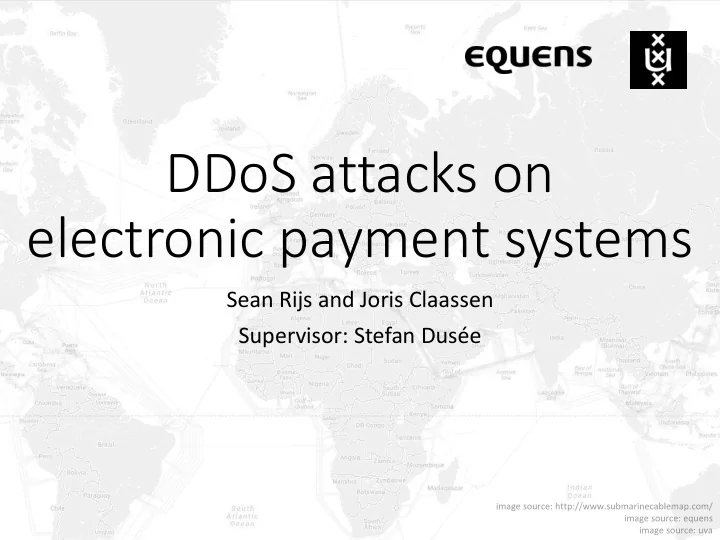

DDoS attacks on electronic payment systems Sean Rijs and Joris Claassen Supervisor: Stefan Dusée
Scope • High volume DDoS attacks • Electronic payment systems • Low bandwidth requirements: € 5 from account X to account Y 2
Research Question What is the implementation difficulty and how effective is a subset of DDoS protection measures to keep electronic payment systems available? • Whitelisting • Robust DNS resolution • Scrubbing 3
DDoS testing environment 4
DDoS testing environment Generate attack packets from our C&C desktop: parallel-ssh -h nodes \ sudo hping3 --flood -S 172.16.1.10 \ --destport 5001 --data 8000 5
Whitelisting 6
Whitelisting Implementation difficulty: iptables - A FORWARD -i eth0 - s 145.100.0.0/15 - j ACCEPT iptables - A FORWARD -i eth0 - j DROP ip6tables - A FORWARD -i eth0 - s 2001:610::/32 - j ACCEPT ip6tables - A FORWARD -i eth0 - j DROP 7
Whitelisting Hyphotisis: • Ingress link will be saturated • Packet loss will occur on the opposite port • Whitelisting should not be effective 8
Whitelisting Test: • hping3 -c 1000 --fast targetvm • sends 1000 TCP packets, 10 packets per second 9
Whitelisting Results: • DDoS attack on VM with 1Gbps link 10
Whitelisting Cause: • Packets never reach the whitelist 11
Whitelisting $snmpwalk -Os -c public -v 1 switchaddress ifOutDiscards ifOutDiscards.1 = Counter32: 3248 ... ifOutDiscards.20 = Counter32: 3251 ifOutDiscards.21 = Counter32: 272661695 RFC1158: "The number of outbound packets which were chosen to be discarded even though no errors had been detected to prevent their being transmitted. One possible reason for discarding such a packet could be to free up buffer space." 12
Robust DNS Resolution • DNS • Not designed with DDoS in mind • Confidentiality, Integrity, Availability • DNS is not confidential • Integrity can be guaranteed using DNSSEC • But falls out of scope • Availability 13
Robust DNS Resolution Hypothesis: • TCP should be more reliable • Due to retransmitting of packets • Distributing DNS • Anycast 14
Robust DNS Resolution Test; UDP vs TCP: 15
Robust DNS Resolution Cause: • TCP ACK retransmit failed • More congestion • More TCP retransmits • TCP slows down packet flow • But this does not even matter • DDoS keeps the ingress link full 16
Robust DNS Resolution • Anycast does work • Global network required • DNS Root servers • Attacked many times 17
Scrubbing Tunnel Internet Normal Traffic Traffic while under DDoS Border router(s) Border router(s) Electronic Payment System Users Scrubbing Centre 18
Scrubbing • Traffic redirection • BGP anycast • On-demand / always-on • Scrubbing Centre • Blackholing • Sinkholing 19
Scrubbing Hypothesis: • The local endpoint is vulnerable • We can hide the local tunnel endpoint 20
Scrubbing Test; hiding the local endpoint; no filter: user@client:~$ traceroute 172.16.1.2 traceroute to 172.16.1.2 (172.16.1.2), 30 hops max, 60 byte packets 1 172.16.1.1 (172.16.1.1) 0.267 ms 0.255 ms 0.246 ms 2 172.16.1.2 (172.16.1.2) 0.401 ms 0.356 ms 0.338 ms user@client:~$ traceroute -U 172.16.1.2 traceroute to 172.16.1.2 (172.16.1.2), 30 hops max, 60 byte packets 1 172.16.1.1 (172.16.1.1) 0.293 ms 0.268 ms 0.250 ms 2 172.16.1.2 (172.16.1.2) 0.358 ms 0.342 ms 0.326 ms user@client:~$ sudo traceroute -T 172.16.1.2 traceroute to 172.16.1.2 (172.16.1.2), 30 hops max, 60 byte packets 1 172.16.1.1 (172.16.1.1) 0.235 ms 0.207 ms 0.183 ms 2 172.16.1.2 (172.16.1.2) 0.347 ms 0.326 ms 0.320 ms 21
Scrubbing Test; hiding the local endpoint; applying filter: Drop all incoming packets iptables -A INPUT -i eth0 -j DROP ip6tables -A INPUT -i eth0 -j DROP Accept packet forwarding from tunnel endpoint iptables -A FORWARD -i eth0 -s 172.16.1.3/32 -j ACCEPT iptables -A FORWARD -i eth0 -j DROP ip6tables -A FORWARD -i eth0 -s 2001:DB0::1/128 -j ACCEPT ip6tables -A FORWARD -i eth0 -j DROP Prevent packets to be sent out iptables -A OUTPUT -i eth0 -j DROP ip6tables -A OUTPUT -i eth0 -j DROP 22
Scrubbing Test; hiding the local endpoint; after applying filter: user@client:~$ traceroute 172.16.1.2 traceroute to 172.16.1.2 (172.16.1.2), 30 hops max, 60 byte packets 1 * * * 2 172.16.1.2 (172.16.1.2) 0.309 ms 0.324 ms 0.317 ms user@client:~$ traceroute -U 172.16.1.2 traceroute to 172.16.1.2 (172.16.1.2), 30 hops max, 60 byte packets 1 * * * 2 172.16.1.2 (172.16.1.2) 0.519 ms 0.530 ms 0.525 ms user@client:~$ sudo traceroute -T 172.16.1.2 traceroute to 172.16.1.2 (172.16.1.2), 30 hops max, 60 byte packets 1 * * * 2 172.16.1.2 (172.16.1.2) 0.386 ms 0.352 ms 0.394 ms 23
Scrubbing But… • No golden ticket • Depends on secrecy of IP address • Of the local tunnel endpoint • Social engineering • Internal documents 24
Conclusion • Whitelisting • Does not protect against high volume DDoS attacks • Robust DNS Resolution • TCP performs worse then UDP • Anycast works • And helps keeping DNS-based applications available • Scrubbing • Does protect against high volume DDoS attacks • But… • Only when combined with whitelisting • And secrecy of the local tunnel endpoint IP 25
Future research • Layer 7 DoS attacks in electronic payment systems • Combining layer 3/7 attacks also known as "smoke and mirrors" • What is the best way to create a deterministic DDoS setup 26
Future research DDoS attack on VM with 100Mbps link 27
Questions
Recommend
More recommend